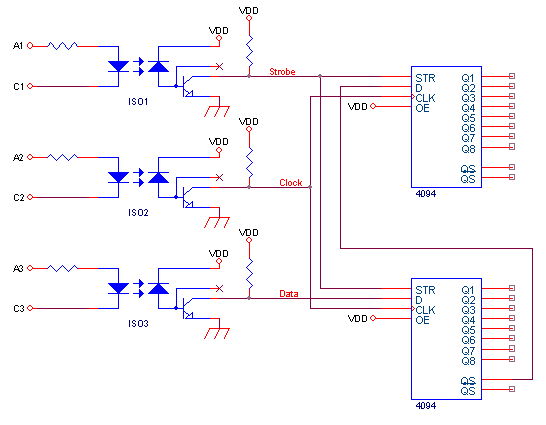
#Eight bit double buffered parallel to serial converter. serial
MODE BIT M 8 7 6 5 4 3 2 1 Serial Shift Left Input DL Shift Right Input DR M=1 Shift Right M=0 Shift Left There are two modes in which this circuit can work namely shift mode or load mode.ġ9 D3 Q3 FF-3 D2 Q2 FF-2 D1 Q1 FF-1 D0 Q0 FF-0 B0 CLK B1 B2 B3 6 5 4 3 2Ģ1 D0 Q0 FF-0 D1 Q1 FF-1 D2 Q2 FF-2 D3 Q3 FF-3 CLK 8 7 6 5 4 3 2 1 The binary input data B0, B1, B2, B3 is applied through the same the combinational circuit.

Output of pervious FF is connected to the input of the next via a combinational circuit. In this operation the data are entered parallel. ONLY ONE CLOCK IS ESSENTIAL TO LOAD ALL THE BITS. The loaded bits will appear simultaneously to the output side. As soon as a positive clock edge is applied, the input binary bits will be loaded into the flip-flops simultaneously. The 4-bit binary input B0, B1, B2, B3 is applied to data inputs D0, D1, D2 and D3 respectively of the four flip-flops. D3 Q3 FF-3 D2 Q2 FF-2 D1 Q1 FF-1 D0 Q0 FF-0 Din CLK Hence the speed of operation of SIPO mode is same as that of SISO mode. Number of clock cycles required to load a four bits data is 4. The output are disabled as the loading is taking place. That means first the data is loaded bit by bit. In this operation the data is entered serially and taken out in parallel.

Q0 FF-0 D1 Q1 FF-1 D2 Q2 FF-2 D3 Q3 FF-3 Din CLK Serial Output FF- 3will SET and the stored data changes to, Q3Q2Q1Q0 = Din 1 1 1 1 1 Q3 D3 Q2 D2 Q1 D1 Q0 D0 FF-3 FF-2 FF-1 FF-0 CLK Serial Data OutputĬLK Q3 Q2=D3 Q1=D2 Q0=D1 Serial input Din = D0 1ġ5 Serial input Serial Output (Shift Right Mode) As soon as the next positive edge of the clock hits. FF- 2will SET and the stored data changes to, Q3Q2Q1Q0 = Din 1 1 1 1 Q3 D3 Q2 D2 Q1 D1 Q0 D0 FF-3 FF-2 FF-1 FF-0 CLK Serial Data Outputġ3 Serial input Serial Output (Shift Left Mode)Īpply the NEXT bit to Din. FF- 1 will SET and the stored data changes to, Q3Q2Q1Q0 = Din 1 1 1 Q3 D3 Q2 D2 Q1 D1 Q0 D0 FF-3 FF-2 FF-1 FF-0 CLK Serial Data Outputġ2 Serial input Serial Output (Shift Left Mode)Īpply the NEXT bit to Din. On the first falling edge of clock, the FF-0 is SET and the stored data in the register is Q3Q2Q1Q0 = Din 1 1 Q3 D3 Q2 D2 Q1 D1 Q0 D0 FF-3 FF-2 FF-1 FF-0 CLK Serial Data Outputġ1 Serial input Serial Output (Shift Left Mode)Īpply the NEXT bit to Din. So Din = D0 = 1.ġ0 Serial input Serial Output (Shift Left Mode)Īpply the clock. I/P FF3 FF2 FF1 FF0 O/P FF3 FF2 FF1 FF0 O/P I/P FF3 FF2 FF1 FF0 I/P O/P I/P FF3 FF2 FF1 FF0 O/Pĩ Serial input Serial Output (Shift Left Mode)ĭin Q3 D3 Q2 D2 Q1 D1 Q0 D0 FF-3 FF-2 FF-1 FF-0 Serial Data Output CLK Serial Shift left register Before application of clock let assume all outputs are zero and apply MSB bit of the number to entered to Din. After 4-clk pulse the required o/p is available serially. PISO All i/p bits are applied simult and.

SISO (Shift Left) Data bits shift from Right to Left by 1 position per clock cycle. SISO (Shift Right) Data bits shift from Left to Right by 1 position per clock cycle. Mode of operation Serial in serial out (SISO) Shift Right Shift Left Serial in Parallel out (SIPO) Parallel in Serial out (PISO) Parallel in Parallel out (PIPO)Ĩ Shift Register Comments Mode Illustrative Diagram 1. Then the clock is applied and corresponding output will be Q3Q2Q1Q0 = B3B2B1B0 =ĥ Buffer Register 4 bits input B3 B2 B1 B0 Q3 D3 Q2 D2 Q1 D1 Q0 D0 FF-3Ĥ bits input B3 B2 B1 B0 1 1 Q3 D3 Q2 D2 Q1 D1 Q0 D0 FF-3 FF-2 FF-1 FF-0 CLK 1 1 Q3 Q2 Q1 Q0 Outputs

Operation The data is to be stored is B3B2B1B0 = These bits are connected to each D-Flip-flops. But here it is a positive triggered D flip-flop. The “n-bit” register will consist of “n” number of flip flops.Ĥ Buffer Register Constructed by using D flip-flop. Such a groups of flip-flop is known as a “Register”. To increase the storage capacity in terms of number of bits, we have to use a group of flip-flop. Shift Registers and their modes Bidirectional Shift Register Universal Shift Registerģ Introduction Register is an important application of Flip-Flop.įlip- Flop is a 1 bit memory cell which can be used for storing the digital data. Presentation on theme: "Shift Registers."- Presentation transcript:Ģ Topics Introduction Buffer Register Classification of Register


 0 kommentar(er)
0 kommentar(er)
